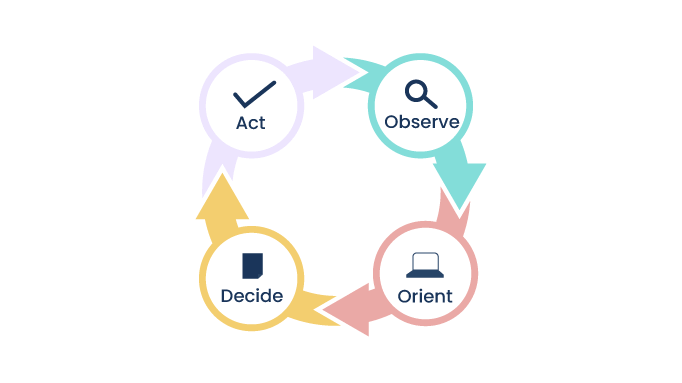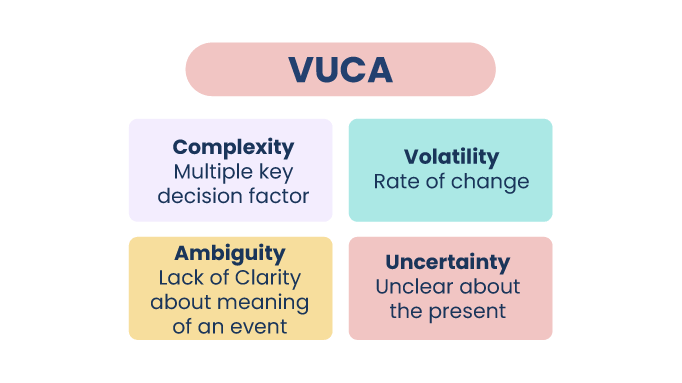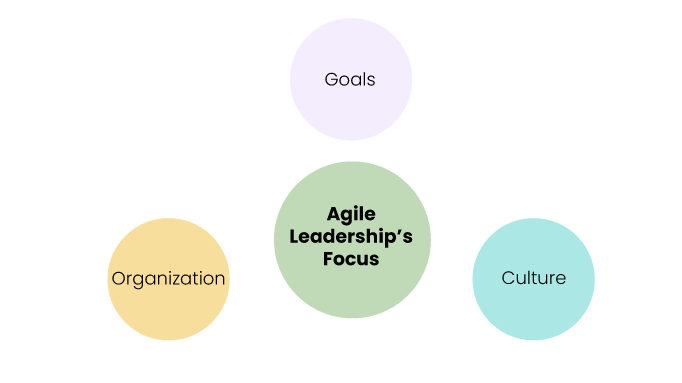How Agile Leadership Is Going To Change Your Business
Agile leadership is a new approach to leading people. It enables organizations to drive innovations and adapt to their changing environment. Agility is a leadership mindset for the next generation of business leaders.
Today's markets recognize organizations that have the capacity and willingness to adapt. Market leaders have established cultures and management approaches that encourage agility. Research shows that 60% of companies experienced growth in profits after agile development.
The need for agility was only intensified by the challenges COVID-19 presented. Also, remotely collaborating made us flex our agile muscles more than ever.
Chris James, CEO of Scaled Agile, Inc., shared, "93% of business units that had fully adopted an agile model before the current pandemic did better than business units that hadn't" (Global SAFe Summit 2020).
To be agile is to be quick and alert. It's an ideal quality in a leader. Agile Leaders pivot faster in response to our volatile, uncertain, and complex world.

Learning to apply the values and principles of agility in your leadership style is vital. It will help you to build teams that will walk through the fire for you.
But, before we begin, let's go over the various topics that will be covered in this article:
- Foundation and history of agile leadership.
- The concept of agile leadership.
- What are the traits and attributes of an agile leader?
- What does an agile leader focus on?
- Difference between agile and traditional leadership behaviors.
- What sets agile organizations apart from traditional ones?
- How can you transform into an agile leader through its principles?
What is Agile Leadership?

Agile leadership is a growth mindset. It is a leadership approach that creates self-management skills. In an agile environment, teams collaborate, learn and get quick feedback from users.
Check out Zaheer Ali as he briefly discusses agile software development and how it has improved businesses around the world. He also addresses how it is changing mainstream society. Zaheer Ali is the Science and Mission Operations Laboratory Supervisor for NASA's SOFIA program.
Agile leaders do not micromanage the people nor create total freedom. They make a balance between anarchy and strict structure.
Agility is based upon the concept of the OODA loop. The OODA loop is a four-step approach to decision-making. It focuses on filtering available information, putting context, and making appropriate decisions.
OODA stands for-
- Observe: Ability or technique to be aware of one's surroundings.
- Orient: To align with one's surroundings.
- Decide: To make decisions on how to act.
- Act: To act according to the decisions made.

The OODA was developed in the 20th century by military strategist John Boyd. This strategy is used both at an individual and organizational level. The military initially used OODA to train soldiers to make time-sensitive decisions. The goal of the strategy was to execute the process quickly to infiltrate and disrupt the enemy's decision cycle.
Now applied to various fields, the OODA is useful in VUCA environments where circumstances frequently change. VUCA stands for-
- Volatile: Challenges are unexpected and are of unknown duration. Knowledge about the challenges is often available.
- Uncertain: Despite a lack of information, the events' basic cause and effects are known.
- Chaotic: The situation has many interconnected parts and variables. Some information is available, but the nature of it is overwhelming to process.
- Ambiguous: Casual relationships are completely unclear. There are no precedents; hence, you face "unknown unknowns."

Making quality decisions in such environments is important to survive and win. The OODA loop provides an approach to improve decision-making.
Agile leadership, like the OODA loop, is about building high-performance teams. In organizational settings, agility has become a tool of choice. It helps to succeed in complex and uncertain VUCA environments.
Agile leaders apply agile principles in their processes, structures, and people development activities. These principles help to increase competitiveness.
Agile leaders make use of the OODA loop to react and handle the VUCA environments. They give their team the mandate and freedom to make their own decisions. Such leaders also train team members to respond to new market changes and technological opportunities.
Agile teams develop self-managing skills. Hence, this leadership style fits well in today's culture. It gives autonomy to employees to do their work and not tell people what to do.
Next, being agile also fits with the concept of customer-centricity. For instance, Modern customers mostly interact through digital devices. Organizations are hence becoming more digital with the rise of mobile phones and the internet. Agile leaders ensure that they respond to customer feedback and keep customer satisfaction high. To achieve that, they give their teams access to NPS (Net Promoter) and CES (Customer effort score).
Foundation and History of Agile Leadership

Agility is a decision-making and decision-implementation framework. Agility has become a buzzword in the past few years. But, the concept has been used for decades in various contexts.
It stemmed from evolutionary biology to refer to a survival mechanism. However, agile principles have long been present in military strategies. Countless military leaders have been seen utilizing agile principles. They used it to intercept the decision-making cycle of the enemy.
Beyond the military application, agility soon found its way into organizational contexts. The agile movement first began in 2001 within software development. Now, it can be seen in every sector of business.
Traits/ Attributes of an Agile Leader

Agile leaders focus on the needs of others. They acknowledge other people's perspectives. Such leaders give employees the care they need to meet their work and personal goals.
Agile leaders involve employees in decision-making. They build a sense of community within their teams. Hence, leading to higher engagement, more trust, and stronger relationships.
The agile approach requires flexibility, adaptation, and "out-of-the-box" thinking. Certain attributes are associated with agility, including:
- Humility
- Ambiguity tolerance
- Open
- Curiosity
- Accepting and present
- Creativity
- Continuous learning
- Courage
- Creating inclusive and empowered teams
- Conviction
- Leading by example
- Emotional Resilience
- Critical Thinking
- Being Able To Deal With Frequent Disruption
- Vision
- Flexibility
- Coach instead of command
- Collaborators
- Provide outcomes, not actions
- Leads with transparency
The Focus of Agile Leaders

Agile Leaders focus on three things:
- Goals: A leader's guiding vision leads to the success of an initiative. Goals set by agile leaders are generally strategic and market-focused. Agile leaders collaborate to identify common goals to achieve a higher purpose. They use these goals to inspire others to contribute. They help their employees when things get tough, and they lose track of where they're going.
- Culture: Culture comes from how people treat, work, and interact with each other. But while leaders can't control and dictate this culture, they can enhance it. They can set examples through the behaviors that they model. Agile leaders foster a company culture that values logic and learning. They strive to improve their business outcomes by encouraging constant innovation.
- Organization: The basic agile team structure is very simple. For instance, if we use scrum as an example, there are only three roles:
- Product Owner,
- Development Team, and
- The Scrum Master.
However, agility is not needed in everything in an organization. It's required whenever we are dealing with complexity.
Agile leaders make sure that the different operating models don't destroy each other. They help the organization optimize for flexibility and continuous improvement.
Agile vs. Traditional Leadership Behaviors
| Agile Leadership Behaviors | Traditional Leadership Behaviors |
|---|---|
| They provide vision, strategy, and direction to the company. | They are predictive and plan things for the long term. |
| Agile leaders foster self-organizational skills. | Traditional leaders control the flow of work and assign tasks. | They support their teams by removing what is impeding them. | They concentrate on maximizing use and capacity. |
| Such leaders encourage employees to develop problem-solving skills. | These leaders try to be problem fixers for their subordinates. |
| Agile leaders motivate others by enabling autonomy, mastery, and purpose. | Traditional leaders motivate others by extrinsic incentives. |
| Under agile leadership, management moves to where the information is. For example, participation in sprint reviews. | Under traditional leadership, information flows up the hierarchy through reports and meetings. |
Leadership in Agile Organizations

Organizational agility is a cornerstone of competitiveness, and it can be advocated as the business paradigm of the twenty-first century and the dominant vehicle for competition - Zhang and Sharifi.
Agile organizations are both stable and dynamic. They focus on customers and are-
- Open,
- Inclusive, and
- Non-hierarchical
Organizational survival in today's environment depends on fundamental transformation to become more agile. Agile organizations can thrive in an unpredictable, changing environment.
Hence, organizations that make this transition successful achieve substantive performance like:
- Enhanced organizational growth
- Increased profitability
- Customer satisfaction
- Employee engagement
To transform into an agile organization, it must begin by exceeding its competencies. Hence, leaders should concentrate on the below three sets of capabilities for agile transformations.
They must transform themselves to evolve new agile mindsets and behaviors.
They need to change their teams to practice agile ways of working.
Transform the organization by building agility into the design and culture.
This new kind of agile organization requires a different type of leadership. Leadership shapes culture and is the biggest enabler of successful agile transformations. Each company has their own agile best practices that differentiate from other companies. It is based on its industry, operations, and size.
Agile management gives primacy to adding value to customers. Hence, it is more threatening to the status quo, but it is also more honest about what's at stake. - Steve Denning
The job of an Agile leader is to build and operate an Agile enterprise. Agile leaders create a balanced system that runs the business efficiently. These systems help guide behaviors among each other and other teams.
Leadership in agile organizations practice transparency. Agility requires leaders to be transparent. Transparent leaders are open about their work and share related information.
Agile leaders also remove barriers and change the company to meet employee needs. However, "Yearly performance appraisals and individual bonuses do not fit well with an organization that uses self-organizing teams or squads or roles rather than job descriptions," says trainer and facilitator Willy Zelen.
Transform into an Agile Leader Through its Principles

Many leaders have a difficult time adjusting to agile because they used their experience and practices getting where they are. When faced with a non-traditional hierarchy, it's not uncommon for leaders to try to lean on their past experiences. Leaders tend to revert to traditional behaviors. - Nidhi Srivastava and Carl Shea
Agile leadership principles help navigate the VUCA world. They provide a set of holistic practices that embrace the ever-changing business environment.
These principles provide alternative, non-hierarchical, and non-traditional organizational approaches.
The principles can be listed down in a different format. Like:
- Agile leaders prioritizes strong teams over dominant individuals. They install agile strategies and tools. Teams under agile leaders achieve high levels of task performance.
- It might be that teams work well in an organization. But, it is crucial to hold regular meetings and to set goals. Agile leaders conduct regular planning sessions and give focus to alternative scenarios. Organizations with agile practices use scrum to maintain a trial-and-error attitude. These practices allow organizations to re-align expectations and goals.
- KPIs rooted in product development, organizational output, and employee satisfaction help set boundaries for corporate developments. It also helps measure success, what works and what doesn't work. Agile leaders focus on facts and KPIs (key performance indicators) rather than opinion and intuition. They use KPIs to develop new and innovative processes for change.
- Agile leaders are autonomous and self-determined, hence successful in capturing followers. These characteristics improve employee satisfaction. Agile processes speed up with flat hierarchies and decentralization of power. Transformational leadership style is a concept well-suited for organizations adapting to agility. Transformational leaders empower and inspire people to make decisions based on their knowledge.
- Commitment to agility opens up new opportunities for communication processes. Agile communication is short-cycled that allows for re-alignment and re-adjusting. Agile leaders communicate in cycles aligned with the speed of the industry and business model.
- Technology in agile organizations facilitates interpersonal communication and helps streamline work-flows. It eases out networking efforts through project management platforms that encourage collaboration. Agile leaders use technology to provide opportunities for networking and information sharing.
- Organizations to build agility must understand the changes of the business environment. Agile leaders take external perspectives from external stakeholders to ensure diversity of thought. They try to step back and work on the system rather than in the system.
- Vision is crucial to organizational agility. Every organization needs a strategy and a vision. It helps to determine the path and help establish a shared goal. Agile leaders create a corporate vision or strategy and refer to it frequently. A strong culture of values helps employees and internal stakeholders understand and commit. It also allows external stakeholders to position an organization with useful feedback.
- An organization's brand image determines how it is perceived and what expectations are placed on it. Agile leaders ensure the organization has an accurate outside image.
- Agility means creating change on the one hand and being able to respond to it on the other. Agile leaders understand that structure and chaos are not mutually exclusive. Thus, they maintain a balance of structure and chaos for greater efficiency.

















